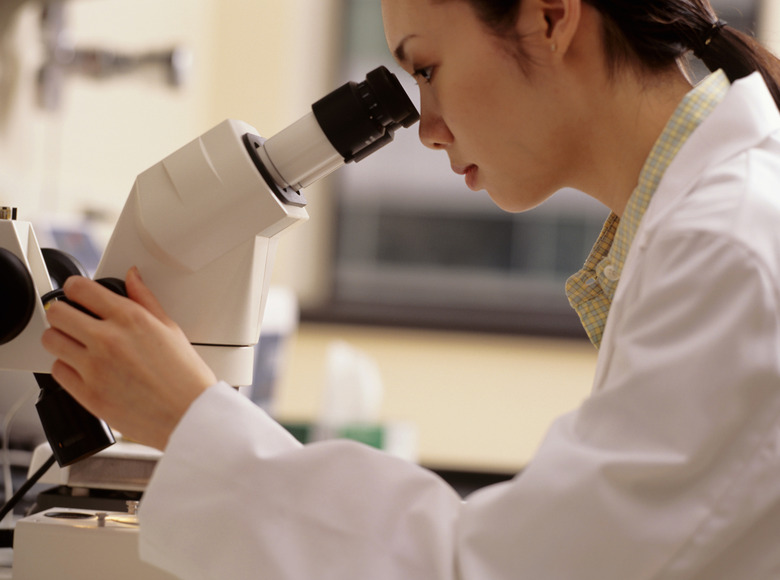How To Label A Binocular Microscope
A distinguishing feature of the binocular microscope is the use of two eyepieces rather than the monocular microscopes' use of just one. As a compound microscope, binocular microscopes use two lenses to magnify the image: an ocular lenses and objective lenses. Simple microscopes, by comparison, have only one lens through which the image is magnified. Understanding the parts and features of a binocular microscope allows greater use of the microscope in the examination of specimens.
Step 1
Identify the eyepieces at the top of the microscope. Binocular microscopes feature two separate eyepieces each with an ocular lens. Both the distance between the eyepieces and the focus of each eyepiece may be adjusted. Label the eyepieces.
Step 2
Find the nosepiece and objective lenses located beneath the eyepiece. Rotation of the nosepiece allows different objective lenses to be selected, changing the magnification of the specimen. The objective lenses may be changed and usually vary in magnification from 10X to 100X (oil immersion). The total magnification of the specimen is determined by the magnification of the ocular lens in the eyepiece and the magnification of the objective lens being used. Label the nosepiece and objective lenses.
Step 3
Locate the structure connecting the base of the microscope with the nosepiece. This structure is the arm of the microscope. In addition to providing structural support to the microscope, the arm is used when carrying the microscope. Label the arm.
Step 4
Identify the stage. The stage is located beneath the objective lenses and holds the specimen at the appropriate distance from the objective lens. The stage is equipped with stage clips to hold the specimen in place. Label the stage.
Step 5
Locate the iris diaphragm underneath the stage. The diaphragm allows the amount of light passing through the stage to be regulated. Label the iris diaphragm.
Step 6
Find the coarse and fine adjustment knobs on the side of the microscope. These adjustment knobs allow the image of the specimen to be focused by adjusting the distance between the specimen and the objective lens. The larger of the two knobs is the coarse adjustment knob and allows broad changes in focus. The smaller of the two is the fine adjustment knob. To prevent damage to the specimen or the objective lenses, the coarse adjustment knob should only be used under lower magnification. Label the coarse adjustment knob and the fine adjustment knob.
Step 7
Identify the light source at the bottom of the microscope. The light source is an electrically powered lamp that provides the light used to view the specimen. Many binocular microscopes are equipped with a lamp rheostat that allows the intensity of the light to be adjusted. A high setting may produce heat sufficient to adversely affect the specimen. Label the light source.
Step 8
Find the base of the microscope. The base provides structural support to the microscope and is used to safely carry the microscope while the other hand is holding the arm.
Things Needed
- Diagram of a binocular microscope
- Pen or pencil
Cite This Article
MLA
Chandler, David. "How To Label A Binocular Microscope" sciencing.com, https://www.sciencing.com/label-binocular-microscope-5815766/. 24 April 2017.
APA
Chandler, David. (2017, April 24). How To Label A Binocular Microscope. sciencing.com. Retrieved from https://www.sciencing.com/label-binocular-microscope-5815766/
Chicago
Chandler, David. How To Label A Binocular Microscope last modified March 24, 2022. https://www.sciencing.com/label-binocular-microscope-5815766/
